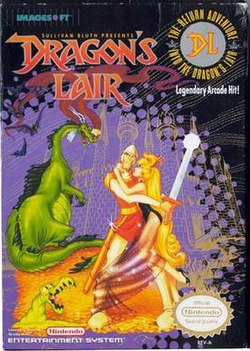Dragon's Lair (Nintendo Entertainment System)
| Dragon's Lair | |
|---|---|
 |
|
| Developer(s) | MotiveTime |
| Publisher(s) | |
| Composer(s) | Mark Cooksey |
| Series | Dragon's Lair |
| Platform(s) | NES |
| Release |
|
| Genre(s) | Action-platformer |
| Mode(s) | Single-player or Two-player (taking turns) |
| Review scores | |
|---|---|
| Publication | Score |
| AllGame | |
| Defunct Games | (F) |
Dragon's Lair (ドラゴンズレア Doragonzu Rea?) is a side-scrolling platform game based on the laserdisc game of the same name released for the Nintendo Entertainment System and developed by the MotiveTime group. Plotwise, the game is identical to the original.
The game has been regarded as a difficult side-scroller, in part due to the slow movement of the main character, particularly evident in the opening screen of the game. Dirk can walk, crawl, or jump forward, and he has an array of weapons that he can discover and use to dispose of enemies. The controller layout is reversed from other mainstream NES titles, with Select functioning as the Pause-button while Start is used for the Candle object (which helps reveal hidden weapons). Also, B is used for jumping, and A for attacking (the input of the A & B buttons is almost always the opposite in similar NES games).
Due to the game's sluggish pace and the fact that most enemies are able to instantly kill Dirk with one touch (only the smallest enemies, such as bats, drain Dirk's life bar instead of killing him outright), the game received extremely negative reviews for its high difficulty level. The game is not unbeatable, but requires the player to learn the timing of the game's enemies and obstacles through repetition. The game's poor controls, lack of checkpoints, and finite number of lives, however, make this nearly impossible and unplayable.
Another factor adding to the game's immense difficulty is the fact that the player can only lose five lives before being forced to start the entire game over. Also, in between levels, the player is taken to an elevator that travels between different floors, like in the arcade game. If the player gets off at the correct floor, they can continue the game. If the player gets off at the wrong floor, they are forced to replay a previous level.
The PAL and Japanese NTSC releases of the game stored the animation data in ROM, which greatly improved the game's frame rate and therefore responsiveness at the cost of a more expensive cartridge. However, the game was still considered remarkably difficult by the European games press.
...
Wikipedia
